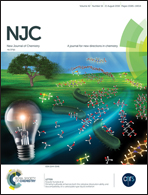Synthesis and crystal structures of salen-type Cu(ii) and Ni(ii) Schiff base complexes: application in [3+2]-cycloaddition and A3-coupling reactions†
Abstract
The synthesis of two new salen-type Schiff base complexes of the type [Cu(L)]·0.5H2O, 1, and [Ni(L)], 2, from the reaction of a 6,6′-[(1E,1′E)-(cyclohexane-1,2-diylbis(azanylylidene))bis(methanylylidene)bis(3-(diethylamino)phenol)] salen-type Schiff base ligand (H2L) with Cu(OAc)2·H2O and Ni(OAc)2·4H2O in methanol at room temperature, respectively, is described. The complexes are isolated as coloured crystalline solids and characterized by elemental analysis, FT-IR spectroscopy, UV-visible spectroscopy and single crystal X-ray diffraction studies. The paramagnetic nature of complex 1, having giso = 2.076, was confirmed by EPR studies, which indicated a distorted square planar geometry of the complex. In contrast to this, the nickel complex was found to be diamagnetic in nature and it was additionally characterized by 1H NMR. The crystal structures of complexes 1 and 2 confirm the distorted square planar geometry of both the complexes. Complex 1 was found to be a better catalyst for the synthesis of a series of 5-substituted 1H-tetrazoles from nitriles and sodium azide via [3+2]-cycloaddition and for the A3-coupling reaction of aldehydes, secondary amines and terminal alkynes with a low catalyst loading (0.7 and 0.9 mol%, respectively) as compared to complex 2. Complex 1 is novel in the sense that, being a homogeneous catalyst, it can be recovered almost quantitatively in both reactions and recycled up to four times to afford good yields of the corresponding products.
![Graphical abstract: Synthesis and crystal structures of salen-type Cu(ii) and Ni(ii) Schiff base complexes: application in [3+2]-cycloaddition and A3-coupling reactions](/en/Image/Get?imageInfo.ImageType=GA&imageInfo.ImageIdentifier.ManuscriptID=C8NJ01718B&imageInfo.ImageIdentifier.Year=2018)


 Please wait while we load your content...
Please wait while we load your content...